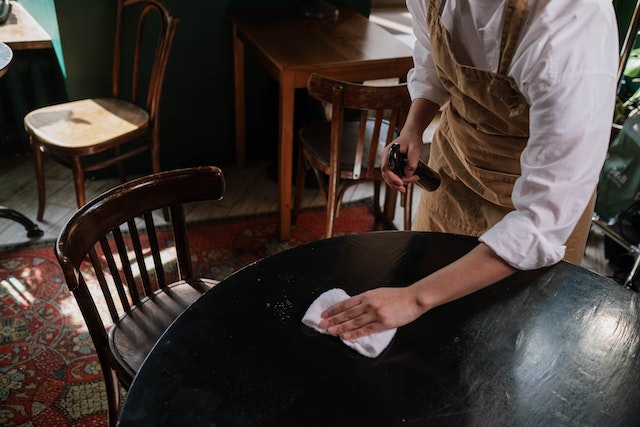While food safety remains a vital issue for health and safety in restaurant kitchens, not every part of the premises receives the same careful attention. These sites in particular contain far more germs that can cause the spread of foodborne illness.
Food contamination is a major problem worldwide. Approximately 10% of people will get sick after eating contaminated food each year, and hundreds of thousands of them will die from the resulting illness. While restaurant administrators and staff understand the importance of food safety practices as a way to combat the spread of foodborne illness, not all surfaces receive the same kind of care. These high-contact surfaces often have the most germs in the premises.
Menus
Menus may be one of the hottest touchpoints for the spread of foodborne illness. These laminated sheets or books may hold as many as 185,000 bacteria per square centimeter. The chief reason for this problem lies in proximity and frequency. Menus are touched frequently, sometimes by hundreds of people per day. Once the order has been placed, the menus go back into a stack, where contact allows the germs to spread to one another. Because menus are infrequently cleaned, if at all, the bacteria continues to spread for several days.
Tables
Without regular sanitation of restaurant tables, a single bacterium continues doubling. Researchers estimate that even the most minor contamination of a table can lead to billions of bacteria within hours. Although tables often receive a better cleaning with restaurant cleaning supplies than menus, the cleanliness of these supplies raises several questions. Restaurant staff who use the same washcloth to wipe several tables may inadvertently be spreading bacteria from one table to others. Proper sanitation requires the use of clean tools and sanitizing equipment, but many restaurants lack the staff or time to complete the task between customers.
Chairs
When it comes to breeding spots for bacteria and viruses, chairs present a unique problem. Like tables, restaurant chairs are usually not sanitized between customers and may not even be wiped down regularly. Booth seats, chairs with cushions, and infant high chairs tend to be the worst culprits for growing pathogens. Research estimates that the average restaurant chair contains as much as 184 individual bacteria per square centimeter. These sources are more likely to have examples of intestinal bacteria, such as E. coli.
Toilets
People expect toilets to be dirty and germ-ridden, but even a thorough daily cleaning is not sufficient to combat the spread of bacteria. As the most frequent touchpoint, the toilet seat is the worst of everything in the bathroom. People enter the bathroom after touching the restaurant table, chair, menu, and possibly their own food before they touch the seat. Even if they wash their hands properly afterward, the contact has already happened. Research shows that toilet seats are more likely to contain drug-resistant bacteria, including Staphylococcus.
Bathroom Floors
In areas like the bathroom floor, the survivability of the pathogens becomes an issue. Restaurant bathrooms often receive a thorough cleaning at least once per day. In between those hours with high traffic, bacteria can flourish. Research demonstrates that even bathroom floors that are soaked once a day in a bleach solution will eventually start to grow bacteria at an alarming rate. Although viruses can also be present on bathroom floors, bacteria from skin cells appears to have the best survivability in these conditions.
Ice Machines
The way that restaurants handle the serving of ice can strongly dictate the cleanliness of this surface. A literature review from 2024 showed that most studies indicate that restaurant ice machines have more bacteria than machines producing ice for industrial purposes. Recent research indicates that as much as a quarter of ice used in restaurants tests positive for bacteria. The type and severity depending on the application. Ice machines used to produce ice for food storage are more likely to be contaminated than ice used for drinks, highlighting a key vulnerability in restaurants that use ice machines to perform both functions.
Condiments
Condiment containers, whether they are held in the dining area or back of house, are carriers of all kinds of bacteria. Research shows that, when tracking bacteria spread throughout a restaurant kitchen, spice bottles and condiment containers are contaminated at least half of the time. Researchers suggest that the main reasons condiment containers face such high levels of contamination is that most people do not see them as a threat. In fact, these surfaces can carry bacteria as much as any other surface, which makes them an important consideration for restaurant food safety.
Shared Utensils
Shared utensils, especially those that are used by both staff and patrons, can cause cross-contamination from multiple sources. People touch salad bar tongs, which can transfer bacteria from the food to the plate. Using the same utensils to handle different foods can spread bacteria even further, given that some foods are more likely to carry harmful bacteria than others. The frequency of cleaning or replacement of utensils can help, but only if the food sources remain uncontaminated.
Designing a restaurant to prevent the spread of foodborne illness requires a plan to sanitize all high-touch surfaces. By examining the contamination risk of these surfaces in particular, restaurant administrators can devise sanitation strategies that further minimize the risk of bacterial growth in the restaurant.
SOURCES
World Health Organization (WHO). (2022, May 19). Food safety. Who.int; World Health Organization: WHO. https://www.who.int/news-room/fact-sheets/detail/food-safety
Rathey, A. P. (2024, December 19). Measuring Cleaning Performance Like an Athlete. Cleaning & Maintenance Management. https://cmmonline.com/articles/beware-of-germs-on-the-menu
developer. (2018, May 21). How Many Germs Are On Your Restaurant Table? Sani Professional. https://saniprofessional.com/how-many-germs-are-on-your-restaurant-table/
Patel, D., Stansell, J., Jaimes, M., Ferris, K., & Webb, G. (2016). A Survey of Microbial Contamination on Restaurant Nonfood-Contact Surfaces. Journal of Food Safety, 37(1), e12287. https://doi.org/10.1111/jfs.12287
Ibrahim, K., Tahsin, M., Rahman, A., Rahman, S. M., & Rahman, M. M. (2024). Surveillance of Bacterial Load and Multidrug-Resistant Bacteria on Surfaces of Public Restrooms. International Journal of Environmental Research and Public Health, 21(5), 574. https://doi.org/10.3390/ijerph21050574
Gibbons, S. M., Schwartz, T., Fouquier, J., Mitchell, M., Sangwan, N., Gilbert, J. A., & Kelley, S. T. (2014). Ecological Succession and Viability of Human-Associated Microbiota on Restroom Surfaces. Applied and Environmental Microbiology, 81(2), 765–773. https://doi.org/10.1128/aem.03117-14
Triggiano, F., Apollonio, F., Giusy Diella, Marcotrigiano, V., & Caggiano, G. (2024). State of the Art in Hygienic Quality of Food Ice Worldwide: A Ten-Year Review. Microorganisms, 12(4), 690–690. https://doi.org/10.3390/microorganisms12040690
KIRCHNER, M., GOULTER, R. M., CHAPMAN, B. J., CLAYTON, J., & JAYKUS, L.-A. (2021). Cross-Contamination on Atypical Surfaces and Venues in Food Service Environments. Journal of Food Protection, 84(7), 1239–1251. https://doi.org/10.4315/jfp-20-314
Huber, D. (2015, November 6). Kitchen utensils can spread bacteria between foods, UGA study finds – Center for Tropical and Emerging Global Diseases. Center for Tropical and Emerging Global Diseases. https://ctegd.uga.edu/kitchen-utensils-can-spread-bacteria-between-foods-uga-study-finds/




